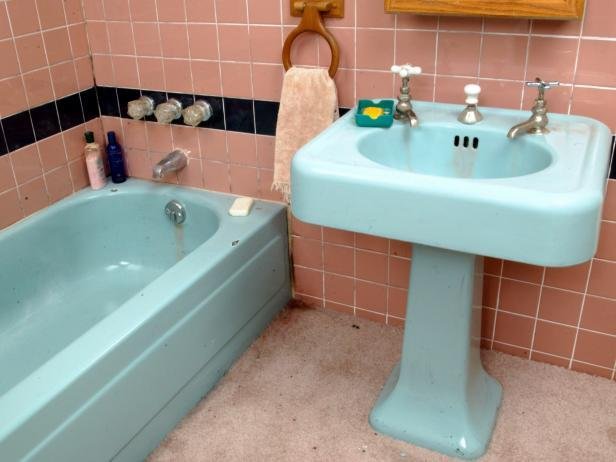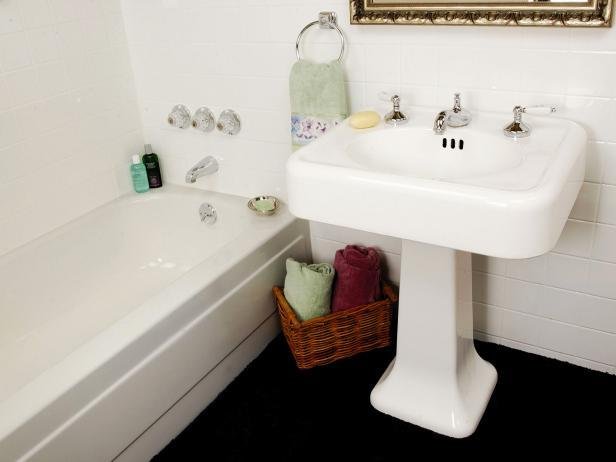You Must Know: Tips From the Pros on Painting Bathtubs and Tile

Do you have an olive green or baby blue bathtub? Thinking about painting it? Before you do, check what options are available.
Does your cherub-pink 1950s bathtub give you nightmares? Mint-green tile surround got you down? If your bathroom tub and tile are in sound condition but simply need an aesthetic makeover, you might be considering repainting or refinishing them yourself. But make sure you know all your options before you pick up that spray gun.
“It really depends on what your long-term goals are,” says Bath Crashers contractor Ryan Prosser, owner of Prosser Construction in Plymouth, Minnesota. “Repainting tile yourself is not a project that will improve your home’s resale value.” Some meticulous homeowners can do an adequate job, Prosser says, but he can always spot a DIY fix vs. one done by a professional.
“Obviously, I’m a bath contractor and I would love to come and rip out your tile,” Prosser says, “but I’m a big believer in saving your money until you can do what you want. Personally, if I can’t buy the best, I just wait.”
But if you can’t stomach the idea of a full-on bathroom remodel—or you want to tone down that electric-blue surround until you can afford the bathroom of your dreams—here are your options:
Call in a professional
A professional tub and tile refinisher can evaluate whether your tile can be rejuvenated rather than replaced. “If it’s in good shape, refinishing is really worth your while, in terms of both cost and the environment,” says Chuck Pistor, president of Miracle Method [LINK: miraclemethod.com], a franchise-based bath and kitchen refinishing company. “We tell people it’s ‘recycling in place’—it keeps all those construction materials out of the landfill. And it costs far less than remodeling.”
Depending on the surface area to be refinished and the amount of repair that’s necessary, a typical tub and tile refinishing job might cost about $1000, Pistor says.
What do you get for the price tag?
Better results. Pros are highly trained, and they have access to better materials than you can't get at a big-box store. Miracle Method, for example, uses a blend of fast-drying acrylic resins that bond tightly with the tile surface. Epoxies designed for home use do not bond as strongly, so they won’t last as long — they’ll likely need touching up or redoing in a year or two. (Miracle Method guarantees its results for five years, although Pistor says that a life expectancy of 15–20 years is more typical.) Epoxies also take longer to dry and turn yellow over time.
More color choices. Home kits are typically limited to basic tones—bisques, whites, and sometimes tints —whereas professionals can give you limitless custom color options.
A shorter time frame for the job. With a pro, you’ll have less down time without your bathroom. Miracle Method typically takes two days to complete a job, and you can use the surface within 24 hours. Unless you’re a refinishing whiz, home kits will probably take you longer than that to prep and apply , and they require 72 hours to cure at an absolute minimum.
Safety. Pros have the proper equipment to reduce your exposure to chemical vapors.
Do the job yourself
If your budget is small and you want to attempt the job yourself, it’s doable. But it isn’t on par with painting your bedroom walls—it requires much greater attention to detail, considerable down time while the paint cures, and ample ventilation. Convinced you want to give it a shot? Here are your dos and don’ts:
Do:
Buy a prepackaged tub and tile kit. Both Rust-Oleum and Homax sell kits that include epoxies designed to work for the job, a complete list of necessary tools and supplies, and step-by-step instructions that you should follow to the letter.
Sand like a maniac. With a home epoxy kit, your job is only as good as the time you spend cleaning and sanding, because a rough surface is your primary source of adhesion. Don’t skimp on this step. The better your prep, the less likely you’ll have to redo in a few years.
Wear a respirator mask and use a fan. Ventilate, ventilate, ventilate. Epoxy is vile stuff to breathe in.
Use a spray gun. Brushing and rolling can work, but a spray gun gives the best finish — use a pro-grade model if you can swing it.
Don’t:
Use regular spray paint. It will look just as expensive and elegant as when you spray-paint a pair of old lawn chairs.
Use water-based paint of any kind. It should go without saying, but water-based paint will disintegrate faster than you can say, “Why me?”
Take a long, hot bath — at least not for a while. Follow instructions about how long the epoxy should cure before you use the tub, and if you can wait even longer, do. Online reviews of kits suggest that impatient users end up with wrinkled surfaces ... and sadness. If you don’t want a permanent print of your rear end on your newly finished tub, postpone a protracted soak as long as you can.

✅ @myotps, I gave you an upvote on your post! Please give me a follow and I will give you a follow in return and possible future votes!
Thank you in advance!
following back